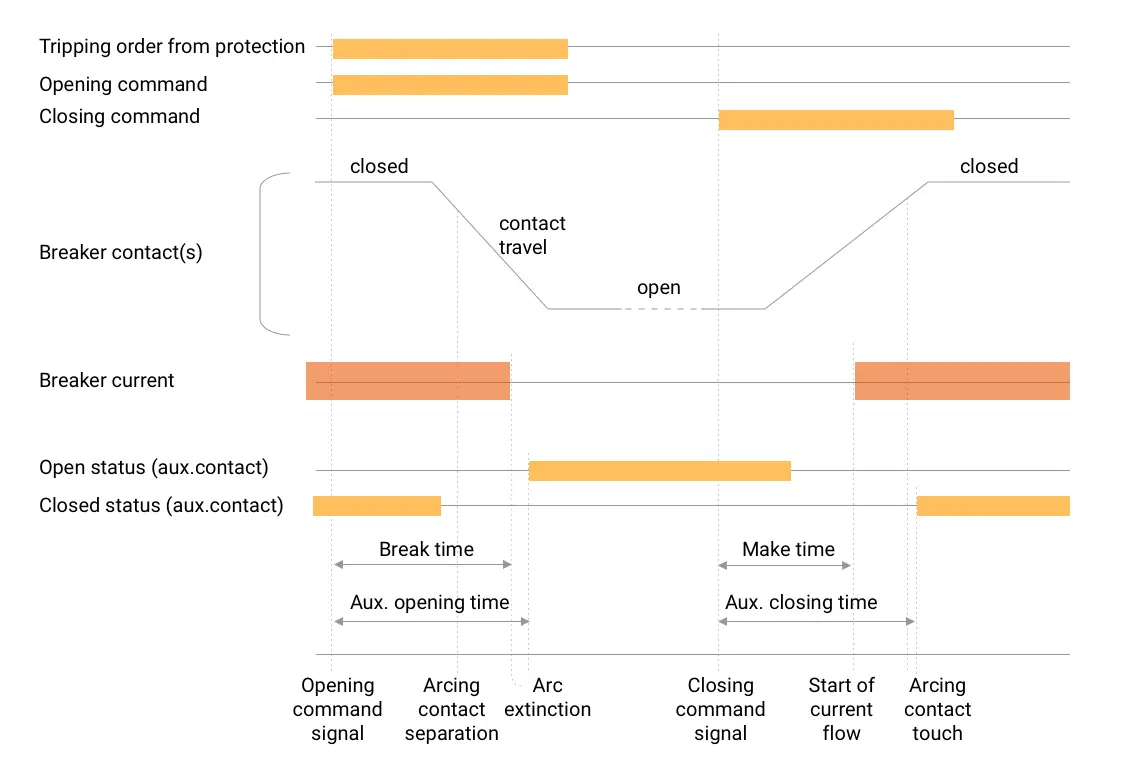Systematic Analysis
The behaviour of the circuit breakers is observed in the same way as for protection relays. The following figure illustrates a circuit breaker opening event followed by a circuit breaker re-closing event and introduces IEC definitions.
These two events may be separated by some seconds or even a longer time.

Circuit Breaker Opening Event
- Measurement of break time: time delay from the rise time of the binary opening command until the current extinction of the considered phase assuming that some current flows before breaking. For each phase current, this delay can be computed.
- Measurement of pole discrepancy: time between the arc extinction of the first phase and the arc extinction of the last phase, in case of three-pole tripping.
- Measurement of the auxiliary opening time: time delay from the rise time of the binary opening command until the opening of auxiliary contact, observed through the rising transition of the « CB open » status signal.
- Measurement of break current: a break current is computed for each interrupted phase current. It corresponds to 1-cycle RMS estimation measured two cycles before the current extinction.
Circuit Breaker Closing Event
In a similar way to the circuit breaker opening event, circuit breaker closing event is related to closing command signal, open and closed status signals and phase currents. The detection of a circuit breaker closing is triggered by a rising closing command signal. After that, it is expected that the currents of the three phases start to flow again and that the circuit breaker status signals change state. Several measurements can be carried out for circuit breaker closing based upon recorded phase currents and recorded binary command and status signals.
- Measurement of make time: time delay from the rise time of the binary closing command until the current appearance of the considered phase. For each phase current, this measurement can be computed.
- Measurement of the auxiliary closing time: time delay from the rise time of the binary closing command until the closing of auxiliary contact, observed through the rising transition of the « CB closed » status signal.
- Measurement of make current: a make current is computed for each phase current and corresponds to peak absolute value during the 4 cycles after the current appearance.
- The measurements allow to characterize the closing event
Circuit breaker Monitoring Rules

All the obtained measurements presented above for both opening and closing events, are compared with thresholds, and the circuit breaker event is considered as normal or abnormal. These thresholds are initially set with default values for the whole set of breakers, but it is possible to also set some specific values to specific breakers.
Arc re-strikes are detected if, during protection-induced tripping, current starts to flow again within 100ms after current interruption for the corresponding pole. Arc re-strike detection produces a specific tag, so that it is possible to subscribe on its notification.
Conditional Maintenance
The sequence of events fuels a set of automated verifications known as circuit breaker monitoring rules. Each rule can produce positive statements that confirm correct operation or it can flag an abnormal behaviour, together with a severity level. The statements resulting from the verifications of every power system event are stored into the database of the software. Experts can confirm (or override) each statement. These confirmations are stored as well, which make the history data very valuable.
Through the “Conditional Maintenance” applications, the archived statements can be looked at according to various grouping and sorting criteria and leveraged for conditional maintenance purposes.
Statistics & Reports – Historical Data
- Given the observed past anomalies of the equipment in different stations and bays, select the equipment that should be inspected first –eventually, as soon as possible in case of critical events like arc restrike in a circuit breaker.
- If a given asset has worked properly in the recent past and a periodical maintenance is scheduled soon, postpone this maintenance by a certain delay (for example 6 months) in order to focus on the equipment that has not been solicited by the power system events.

